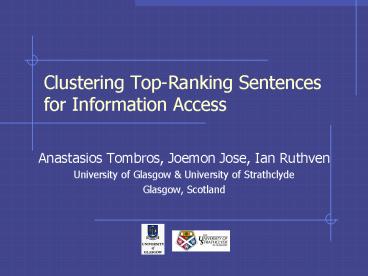Clustering Top-Ranking Sentences for Information Access - PowerPoint PPT Presentation
1 / 8
Title:
Clustering Top-Ranking Sentences for Information Access
Description:
We used 4 searchers with a total of 16 queries. each searcher assessed the utility of the top 30 ... more searchers & queries, different clustering methods ... – PowerPoint PPT presentation
Number of Views:39
Avg rating:3.0/5.0
Title: Clustering Top-Ranking Sentences for Information Access
1
Clustering Top-Ranking Sentences for Information
Access
- Anastasios Tombros, Joemon Jose, Ian Ruthven
- University of Glasgow University of Strathclyde
- Glasgow, Scotland
2
Some Background Motivation
- Challenge How to provide effective access to
information - Approach Combine clustering top-ranking
sentences (TRS) - clustering has been used extensively on the
document level - TRS are based on single document summaries
- Overall aim of the work
- to create a personalised information space
- to use information from users interaction
3
Top-Ranking Sentences
- Assume a user with a query
- the query is sent to an IR system
- consider only the top retrieved documents, e.g.
30 - apply a query-biased sentence extraction model to
each of these documents - construct a sentence extract of max. 4 sentences
per document - the set of these sentences for the 30 documents
is the set of TRS - TRS can be ranked by their query-biased scores
4
Top-Ranking Sentences (cntd.)
- TRS have shown to be effective in interactive IR
on the Web - they provide effective access to the retrieved
information - They can be seen as a level of abstraction of the
set of retrieved documents - We introduce an extra layer of abstraction by
clustering the set of TRS
5
Clustering Top-Ranking Sentences
- An attempt to create a personalised information
space - sentences give local contexts in which query
terms occur - sentences discussing query terms in similar
contexts should cluster together - this structure should facilitate a more intuitive
and effective access to information - Similarities and differences to document
clustering
6
Comparing TRS and Document Clustering
- We used 4 searchers with a total of 16 queries
- each searcher assessed the utility of the top 30
documents on a scale of 1-10 - For each query
- we downloaded the top-30 retrieved documents
- we extracted the set of TRS
- we clustered the 30 documents and the set of TRS
- we assigned scores to document TRS clusters
- sum of the document (sentence) scores divided by
the number of documents (sentences) in the cluster
7
Some Results
- Scores of TRS clusters were significantly higher
than those of document clusters - best cluster averages 4.78 vs. 5.82
- overall averages 3.2 vs. 3.73
- Average precision and recall were higher for TRS
clusters - define P R based on documents with scores 7
- average P 0.38 vs. 0.49
- average R 0.73 vs. 0.77
- Cluster sizes were comparable
- 5 docs per cluster vs. 5.3 sentences per cluster
8
Conclusions Future Plans
- TRS clusters have the potential to offer more
effective information access - only one aspect of their expected utility
- Integrate TRS clustering in interactive web
searching - investigate its utility in user-based studies on
the live Internet - We have extended the reported work
- more searchers queries, different clustering
methods - inter-sentence similarities, structure of
information space































